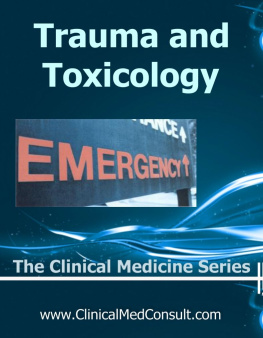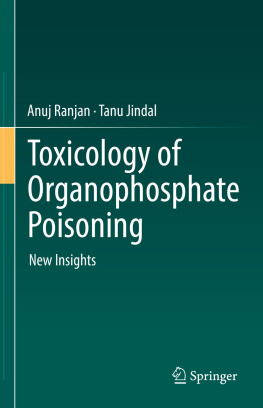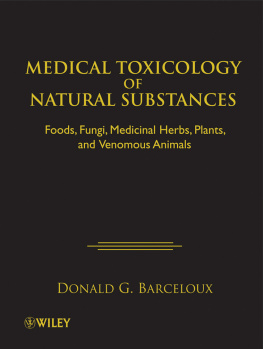Toxicology Handbook
Second Edition
Lindsay Murray
Frank Daly
Mark Little
Mike Cadogan
Churchill Livingstone
Front Matter
Toxicology Handbook
Second edition
Lindsay Murray | Frank Daly | Mark Little | Mike Cadogan

Sydney Edinburgh London New York Philadelphia St Louis Toronto
Copyright

Churchill Livingstone is an imprint of Elsevier
Elsevier Australia. ACN 001 002 357
(a division of Reed International Books Australia Pty Ltd)
Tower 1, 475 Victoria Avenue, Chatswood, NSW 2067
This edition 2011 Elsevier Australia
This publication is copyright. Except as expressly provided in the Copyright Act 1968 and the Copyright Amendment (Digital Agenda) Act 2000, no part of this publication may be reproduced, stored in any retrieval system or transmitted by any means (including electronic, mechanical, microcopying, photocopying, recording or otherwise) without prior written permission from the publisher.
Every attempt has been made to trace and acknowledge copyright, but in some cases this may not have been possible. The publisher apologises for any accidental infringement and would welcome any information to redress the situation.
This publication has been carefully reviewed and checked to ensure that the content is as accurate and current as possible at time of publication. We would recommend, however, that the reader verify any procedures, treatments, drug dosages or legal content described in this book. Neither the author, the contributors, nor the publisher assume any liability for injury and/or damage to persons or property arising from any error in or omission from this publication.
National Library of Australia Cataloguing-in-Publication Data
Title: Toxicology handbook/Lindsay Murray [et al.].
Edition: 2nd ed.
ISBN: 9780729539395 (pbk.)
Notes: Includes index.
Subjects: Toxicology--Australia--Handbooks, manuals, etc. Toxicology--Oceania--Handbooks, manuals, etc.
Other Authors/Contributors: Murray, Lindsay.
Dewey Number: 571.95
Publisher: Sophie Kaliniecki
Developmental Editor: Neli Bryant
Publishing Services Manager: Helena Klijn
Project Coordinator: Geraldine Minto
Edited by Sybil Kesteven
Proofread by Kerry Brown
Cover design by Georgette Hall
Internal design and typesetting by TnQ Books and Journals
Index by Robert Swanson
Printed by 1010 Printing International Limited
Foreword
Poisoning is a common emergency department presentation, and the third major injury cause of hospital admissions after falls and motor vehicle crashes. Alcohol, benzodiazepines, antidepressants, paracetamol and heroin are frequently involved, yet there are literally thousands of hazardous substances that can be ingested, as well as envenomings by terrestrial animals and sea creatures.
The challenge for the emergency physician is to be able to recognise the poisoned patient, provide supportive care, administer a specific antidote in a minority of cases, escalate management up to a full intensive care level when necessary, and know when a patient is safe to be medically cleared pending a thorough psychiatric examination (in cases of deliberate self-harm). This presents a huge challenge to any doctor, who individually may infrequently see a severe poisoning and/or can be confronted with a first case of a particular type.
Clinical Toxicology has developed rapidly as a subspecialty of Emergency Medicine in Australasia, led by a small group of expert clinicians dedicated to providing information, advice, research and teaching in this important area. The authors are in the vanguard of this group. All regularly direct and assist toxicology patient care in emergency departments, intensive care units and small rural hospitals across the country, locally as well through the national Poisons Information Centres.
Their risk assessment-based approach is maintained in this new version that builds on the success of the first edition. This handbook has been updated and expanded with the addition of many new chapters, yet it retains its award-winning format recognised for its lucidity and readability. The compact size of the book belies the true wealth of clear, practical evidence-based information covering a vast array of poisonings and their management in a logical, consistent format.
This book should live in the pocket or at the bedside, be used daily and be referred to as a prevailing standard of care not just in Australasia, but internationally. With the exception of some envenomings, the book will be just as valuable to clinicians in the UK, Europe and Asia as no doubt it will again prove to be here in Australasia. It is a truly outstanding text that will improve the care of poisoned patients to their benefit, and the reader's edification.
Professor Anthony F.T. Brown, MB ChB, FRCP, FRCS(Ed), FACEM, FCEM, Senior Staff Specialist, Department of Emergency Medicine, Royal Brisbane and Women's Hospital, Professor, Discipline of Anaesthesiology and Critical Care, University of Queensland, Editor-in-Chief, Emergency Medicine Australasia, Senior Court of Examiners, ACEM
August 2010
Preface
The overwhelmingly enthusiastic response to the first edition of the Toxicology Handbook confirmed the need amongst emergency medical personnel for readily accessible and practical toxicology information in the context of a systematic approach to the care of the poisoned patient.
Feedback from the users of the handbook from Poisons Information Centres and Emergency Departments in urban, regional and rural settings has allowed us to expand and refine the factual information for the second edition while retaining the standardised formats and risk assessment based approach of the first edition. Routine use of the handbook by junior medical staff in our own Emergency Departments and Toxicology Units in Perth has allowed us to refine any written advice that is potentially liable to misinterpretation by inexperienced users. For the second edition we have added chapters to provide an approach to poisoning by plants and mushrooms and an approach to dealing with the issues of drug dependence, tolerance and withdrawal that frequently complicate management of the poisoned patient. We have also added new chapters for a number of important specific toxins and antidotes, and extensively revised the envenoming chapters in the light of recently published research.
Our sincere hope is that the Toxicology Handbook continues to contribute to excellence in the provision of care of the poisoned patient.
Lindsay Murray
Frank Daly
Mark Little
Mike Cadogan
Jason Armstrong
Kerry Hoggett
David McCoubrie
Mark Monaghan
Jessamine Soderstrom
Ovidiu Pascu
Authors
Lindsay Murray, MBBS FACEM, Consultant Emergency Physician and Clinical Toxicologist, Sir Charles Gairdner Hospital, Perth, WA, Clinical Associate Professor of Emergency Medicine, University of Western Australia
Frank Daly, MBBS FACEM, Consultant Clinical Toxicologist, Emergency Physician and Director of Clinical Service Redesign, Royal Perth Hospital, Professor in Emergency Medicine, University of Western Australia; Consultant Clinical Toxicologist WA and NSW Poisons Information Centres
Mark Little, MBBS DTM&H (Lond) FACEM MPH&TM IDHA, Consultant Emergency Physician and Clinical Toxicologist, Royal Perth Hospital, Clinical Senior Lecturer in Emergency Medicine, University of Western Australia, Consultant Clinical Toxicologist, WA and NSW Poisons Information Centres
Next page






